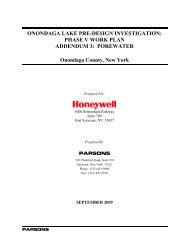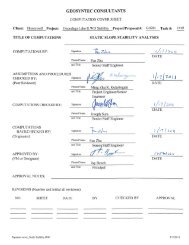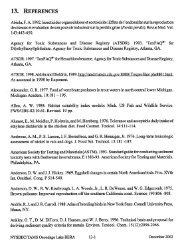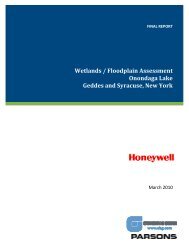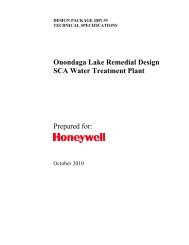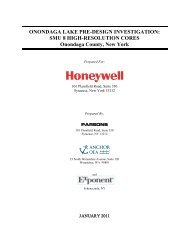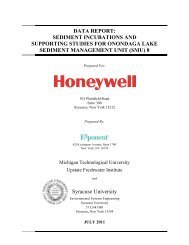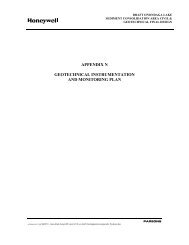Phase 1B Underwater Archaeological Report for the Onondaga ...
Phase 1B Underwater Archaeological Report for the Onondaga ...
Phase 1B Underwater Archaeological Report for the Onondaga ...
Create successful ePaper yourself
Turn your PDF publications into a flip-book with our unique Google optimized e-Paper software.
FINAL<br />
<strong>Phase</strong> IB <strong>Underwater</strong> <strong>Archaeological</strong> Resources <strong>Report</strong> <strong>for</strong> <strong>Onondaga</strong> Lake Superfund Site<br />
Anomaly 12: Derrick Lighter Spud Barge<br />
Anomaly 12 Summary Table<br />
Anomaly Identification Derrick Lighter Spud Barge; NY Site Number 06740.012296<br />
Remedial Impact<br />
Dredge and Cap<br />
NRHP Eligibility<br />
Eligible as Contributing Property to Syracuse Maritime Historic District<br />
Recommendation<br />
Anomaly Dataset<br />
Side Scan (2005) 255<br />
Magnetometer (2005) 684, 629, 253, 618, 646, 671, 659, 265<br />
Side Scan (2010) 6/3/10<br />
Sector Scan (2010) 6/4/10<br />
ROV Video Footage (2010) 6/9/10<br />
Diver Observations No<br />
Diver Videography<br />
No<br />
Maps/Charts<br />
Yes<br />
Aerial Imagery<br />
Yes<br />
Historic Accounts<br />
No<br />
Research Results<br />
A12 is an edge-fastened, wooden derrick lighter spud barge. The barge is preserved up to <strong>the</strong> deck<br />
level, although <strong>the</strong> deck is no longer present. A wreck marker appears in <strong>the</strong> vicinity of A12 on a 1942<br />
navigational chart (see Figure 37), and <strong>the</strong> site is clearly visible on modern aerial photographs (Figure<br />
51). The mechanisms <strong>for</strong> holding <strong>the</strong> spuds are exposed above water, with <strong>the</strong> remainder of <strong>the</strong> barge is<br />
just below <strong>the</strong> water’s surface.<br />
During <strong>the</strong> <strong>Phase</strong> <strong>1B</strong> fieldwork, site conditions were ideal <strong>for</strong> recording sector scan (Figure 52) and side<br />
scan imagery (Figure 53), as well as a detailed visual inspection due to excellent water clarity. The<br />
barge’s principal extant members are its vertical edge-fastened sides, vertical ends, four longitudinal<br />
bulkheads, floors, framing, spud holders, and mast step. The vessel is 88 feet (26.82m) long and 32 feet<br />
(9.75m) wide. A12 is edge-fastened every +/- 18 inches (45.72cm) along <strong>the</strong> 4in (10.16cm) thick sides<br />
with framing every 3 to 4 feet (.91m to 1.22m). There are 4 bulkheads, also edge-fastened (Figure 54).<br />
The framing system consists of futtocks with a clamp holding <strong>the</strong> joint between futtock/floor. The<br />
original use of <strong>the</strong> barge as a derrick lighter spud barge is defined by <strong>the</strong> spud holders and mast step.<br />
The spud holders are located on both sides of <strong>the</strong> vessel on <strong>the</strong> eastern end of <strong>the</strong> barge (Figure 55).<br />
Spuds are vertical posts which could be raised and lowered to hold a vessel in place, and were<br />
commonly used on barges that required maintaining a stationary position in shallow water such as pile<br />
drivers, crane barges, derrick lighters and dredge barges. The spud holder is composed of two iron<br />
horizontal knees which rein<strong>for</strong>ced a vertical wooden channel in which <strong>the</strong> spud was housed. The side of<br />
<strong>the</strong> hull around <strong>the</strong> spud holder was protected with sheet iron and framed more heavily than <strong>the</strong> rest of<br />
<strong>the</strong> hull. Iron chain plates were noted along <strong>the</strong> sides of <strong>the</strong> barge adjacent to <strong>the</strong> spud holder.<br />
Chainplates, straps used to hold rigging to <strong>the</strong> boat’s side, secured <strong>the</strong> cable used to raise and lower <strong>the</strong><br />
spuds.<br />
The barge is believed to be a derrick lighter based on <strong>the</strong> presence of a mast step and <strong>the</strong> construction<br />
of <strong>the</strong> barge’s end. The mast step, which is located between <strong>the</strong> spud holders, indicates A12 had a<br />
vertical spar, or mast, stepped in <strong>the</strong> bottom of <strong>the</strong> hull. The mast may have held a derrick which is a<br />
pivoting spar attached to a mast used like a crane to hoist cargo and o<strong>the</strong>r heavy weights. Barges<br />
72



